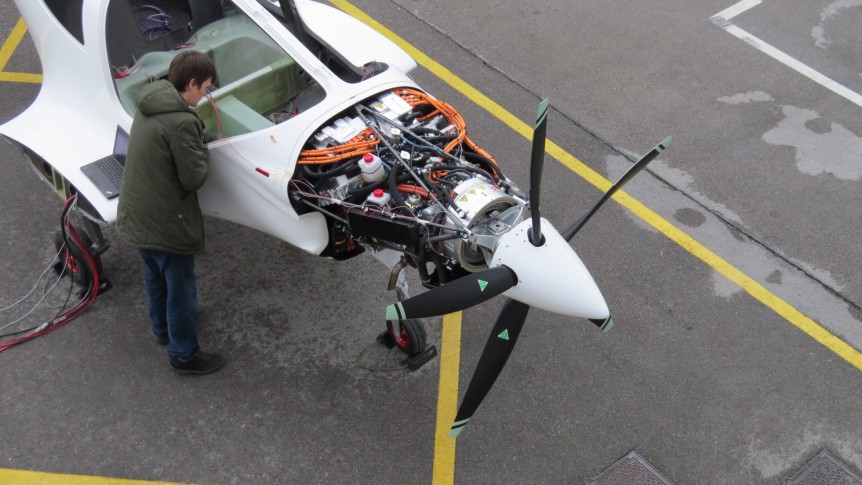Pipistrel took the wraps off its latest iteration of what was originally called the Panthera, the hybrid variant of which has been renamed the HYPSTAIR, a pun that fails to diminish the significance of the achievement. Pipistrel clams the most powerful aerial hybrid electric power train, powering it up on February 9 and making a mighty, but subdued noise, much of it coming from the specially-designed, five-bladed propeller. Putting out 200 kilowatts (268 horsepower) at full throttle, the Siemens motor turned the propeller using first just the generator, and then the motor in low and high power modes. The propulsor (perhaps a new term to consider as hybrid power becomes a common operational type for electric aircraft) produces 100 kW (134 hp.) from the generator driven by a turbonormalized internal combustion engine, and the top rated power from the drive motor (150 kW continuous, or 201 hp.). These impressive numbers allow the HYPSTAIR to achieve the same kinds of performance of …
WATTsUP at Pipistrel
No, that’s a statement and not a question. Taja Boscarol of Pipistrel sent the following announcement this morning. WATTsUP, their new two-seat electric trainer took its maiden flight on August 8th. As part of its 25th anniversary celebrations, Pipistrel will display the airplane at the Salon de Blois airshow, France, on 30-31 August 2014. This is the third announcement of an electric trainer by a major aircraft manufacturer, counting Airbus with its anticipated e-Fan developments and American Electric Aircraft Corporation (AEAC) with its Sun Flyer. We could count four with Adventure Aircraft’s EMG-6 under development in California for the ultralight market. This would mark a potentially historic turnaround for General Aviation, with promised operating costs significantly lower than for internal-combustion powered machines, and by inference, lower rental costs for student pilots. One of the most exciting parts of the announcement – the price: “Pipistrel expects to bring the final product to the market in 2015 with a target price below …
EADS, Partners Open Electric Airplane Campus
The European Aeronautic Defense and Space Co. (EADS), IABG – a company providing analysis and testing for aerospace companies, and Siemens AG are collaborating along with educational partners the Technical University of Munich (TUM), the Bundeswehr University Munich, the Munich University of Applied Sciences, Bauhaus Luftfahrt, and the German Aerospace Center (DLR) to form the Ludwig Boelkow Campus consortium. Consortium partners have also signed a declaration of intent governing future cooperation between the newly founded Ludwig Boelkow Campus GmbH and the Munich Aerospace e.V., aerospace faculty. Named after an aerodynamicist who worked under Antony Fokker, and who headed development of the Messerschmidt ME-262 jet fighter in WWII, the campus will integrate multiple academic disciplines and industries in work designed to foster creative new ways of designing, building, and powering aircraft. With a primary goal to research areas of future flight, the campus and its industrial partners will help further development of next-generation European aircraft. As explained by EADS, projects reflect …
EADS Pulls Off Electric Hat Trick at 2011 Paris Air Show
At the 2011 Paris Air Show at Le Bourget this week, the European Aeronautic Defense and Space Company N.V. (EADS) showcased at least three electric flight vehicles – two emonstrating current reality and one pointing toward a cleaner future for short-to-medium range airliners. Cri-Cri, the four-motored, contra-rotating props on stalks aerobatic wonder, did indeed perform at the 2011 Paris Air Show, doing six-minute routines daily at the show. Didier Esteyne, the plane’s obviously accomplished pilot, explains things in this video. http://www.youtube.com/watch?v=76h4VA3yoNI Emmanuel Joubert, Program Head for the All-electric Cri-Cri at EADS, explained the plane’s advantages. “In all-electric mode, the plane’s performance during climb and aerobatics is better compared to a conventional aircraft of this type. This allows the pilot to really have ‘fun flying’ – with no noise and high torque at low and high speed.” Because of the light weight and small size of the Cri-Cri, initial flights were limited to 20 minutes, but now run 30 minutes, with …

